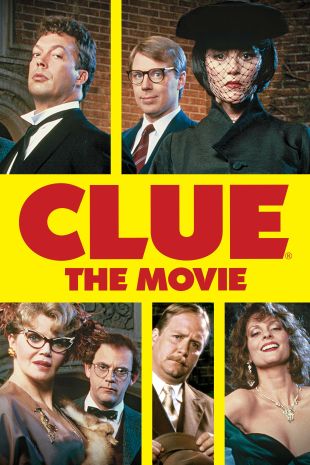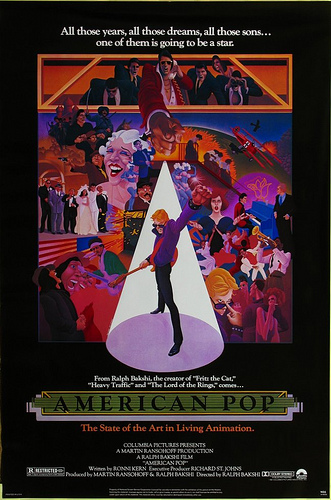It was a dark and stormy night in 1954….
The 1985 comedy, Clue, opens with a set of six strangers arriving at an ominous mansion in New England. They’re meet by Wadsworth (Tim Curry), an oddly charismatic butler who explains that all six of the strangers have a few things in common. They all work in Washington D.C. They are all, in some way, involved with the government. And they’re all being blackmailed by Mr. Boddy (Lee Ving), the owner of the house.
The six strangers have all been assigned nicknames for the night.
Miss White (Madeleine Khan) is the enigmatic widow of a nuclear physicist who may have had communist sympathies. Actually, Miss White is a widow several times over. All of her husbands died in circumstances that were a bit odd. Is Miss White a black widow or is she just unlucky? And what about the flames of jealousy that she occasionally mentions?
Professor Plum (Christopher Lloyd) is a psychiatrist who once worked for the World Health Organization and who has an unfortunate habit of sleeping with his patients.
Mr. Green (Michaele McKean) explains that he works for the State Department and that he is also secretly gay. If his secret got it, he would be deemed a security risk or perhaps even a communist agent.
Mrs. Peacock (Eileen Brennan) is the wife of a U.S. Senator who forced to resign after getting caught up in a bribery scandal.
Colonel Mustard (Martin Mull) is a somewhat stuffy war hero-turned-arms dealer.
And finally, Miss Scarlet (Lesley Ann Warren) is Washington D.C.’s most powerful and most witty madam.
Once everyone is in the house, Wadsworth explains that the police have been called and will arrive in 45 minutes, at which point Mr. Boddy will be arrested and everyone’s secrets will be exposed. Mr. Boddy’s solution is to suggest that one of the six kills Wadsworth. After tossing everyone a weapon, Mr. Boddy turns out the lights. When the lights come back on, Wadsworth is still alive but Mr. Boddy is not. But who murdered Mr. Boddy? And in what room? And with what weapon? And what to make of the other people who were either in the house or show up at the front door, like the maid, Yvette (Collen Camp), or the motorist (Jeffrey Kramer) who shows up to use the phone or the traveling evangelist (Howard Hesseman)? Can the mystery be solved before the police show up and presumably arrest everyone?
Based on the old board game, Clue is a hilariously exhausting film, one that mixes smart wordplay and broad physical comedy to wonderful effect. It’s not often that you see a film that gets equal laughs from two people colliding in a hallway and from characters accusing each other of being communists. In fact, it’s so easy to marvel at the physical comedy (especially the lengthy scene where Tim Curry runs from room to room while explaining his theory about who committed the murders) that it’s easy to forget that the film is also a sharp satire on political corruption, national paranoia, 50s morals, and the McCarthy era in general. Since all of the characters are already convinced that they’re either surrounded by subversives or in danger of being accused of being a subversive themselves, it’s not a great leap for them to then assume that any one of them could be a murderer. I mean, if you’re willing to betray your country than who knows what you might be willing do in the study with a candlestick?
The cast is full of comedy veterans, all of whom know how to get a laugh out of even the mildest of lines and none of whom hold back. Madeline Kahn, in particular, is hilarious as Miss White though my favorite suspect, in both the game and the movie, has always been Miss Scarlet. Not only is she usually portrayed as being a redhead in the game but, in the movie, her dress is to die for. In the end, though, it’s perhaps not a surprise that the film is stolen by Tim Curry’s energetic performance. The film’s final 15 minutes are essentially a masterclass in physical comedy from Tim Curry but he’s just as funny when he’s delivering his frequently snarky dialogue. Both Wadsworth the character and Tim Curry the actor appear to be having a blast, running from room to room and shouting out accusations.
When Clue was originally released, it was released with three different endings. Apparently, the audience wouldn’t know which ending they were going to get before the movie started. I guess that the idea was to get people to go the movie three times to see each ending but I imagine few filmgoers had the patience to do that and who knows how many viewers went to multiple showings just to discover that the randomly selected ending was one that they had already seen. I’m surprised that I haven’t come across any reports of riots breaking out. Fortunately, the version of Clue that is now available for viewing features all three endings. Of course, none of the endings make much sense. Hercule Poirot would demand a do-over, especially if he was being played by Kenneth Branagh. But the fact that it’s all so ludicrous just adds to the comedy. I watched Clue two Fridays ago with a group of friends and we had a blast. It’s definitely a movie that’s more fun when you watch it with other people.
(That said, as far as incoherent solutions are concerned, the third one was my favorite and I think Poirot would agree.)
As for the board game itself, I used to enjoy playing it when I was a kid. We had really old version from the 60s and I always used to imagine what all of the suspects were like when they weren’t being accused of murder. I always imagined that Mr. Green and Miss Scarlet probably had something going on. Today, I’ve got a special Hitchcock edition of the game. It’s all good fun, this never-ending murder mystery.














 Long before South Park, The Simpsons, and Pixar, there was Ralph Bakshi. At a time when animation was considered to only be good for children, Bakshi shocked audiences and critics with animated films that dealt with mature themes and were definitely meant for adults. His first two films, Fritz the Cat (1972) and Heavy Traffic (1973), was the also the first two animated films to receive an X-rating. Bakshi satirized racism in the controversial Coonskin (1975) and Bakshi’s adaptation of The Lord Of Rings (1978) beat Peter Jackson’s by 23 years. It was after the critical and commercial disappointment of the heavily flawed but interesting Lord of the Rings that Bakshi decided it was time to make a film that would be more personal to him. The end result was American Pop.
Long before South Park, The Simpsons, and Pixar, there was Ralph Bakshi. At a time when animation was considered to only be good for children, Bakshi shocked audiences and critics with animated films that dealt with mature themes and were definitely meant for adults. His first two films, Fritz the Cat (1972) and Heavy Traffic (1973), was the also the first two animated films to receive an X-rating. Bakshi satirized racism in the controversial Coonskin (1975) and Bakshi’s adaptation of The Lord Of Rings (1978) beat Peter Jackson’s by 23 years. It was after the critical and commercial disappointment of the heavily flawed but interesting Lord of the Rings that Bakshi decided it was time to make a film that would be more personal to him. The end result was American Pop.